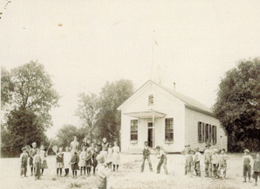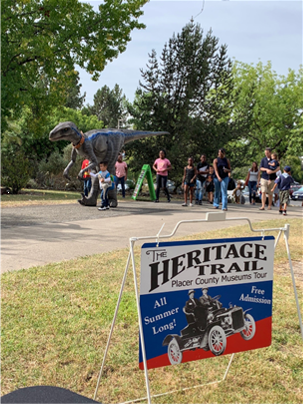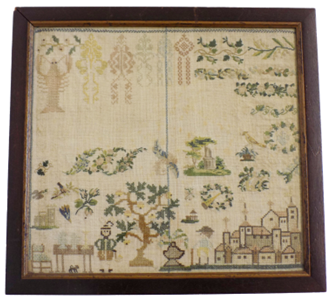Administrator’s Notes
Ralph Gibson, Museums Administrator
For the full summer schedule: theheritagetrail.blogspot.com
Embroidery Samplers
Kasia Woroniecka, Curator of Collections
Samplers date back to the 15th century. Initially they were a reference piece made by skilled needleworkers to record their favorite patterns and stitches for future use in new pieces. The earliest known American sampler was made in 1645 and by the 1700s samplers depicting the alphabet, numbers, religious verses, and decorative designs were made to demonstrate embroidery accomplishments.
Young girls usually began learning to sew at the age of six. They were taught by their mothers, grandmothers, and other female relatives. By the early nineteenth century few girls received an education. Those who could afford it were taught basic reading, writing, dancing and needlework by governesses or were send to boarding schools and female academies to prepare them for marriage. By the time they were fourteen girls would have created several samplers depicting Bible verses, poems, repeating patterns, and even locations of the schools they attended. The completed samplers were often framed and hung in the parlor to display the girl’s skill, and her parents’ status and their belief in the value of education.
There are only a few samplers in our collection. They are all unique, with a variety of motifs and stitches.
This sampler, made in 1807, is the oldest in our collection. The top portion is a carefully stitched alphabet. The middle portion contains a poignant verse: “This work in hand my friends may have when I am dead and in my grave.” It is signed “Catherine Roberts her work done in the Year of our Lord 1807.” The bottom is a design of birds, butterflies, trees, dogs and two figures.
This sampler was made by Jessie Pollock Brown at the Ladies College in Edinburgh, Scotland, in 1895. She was there to receive a higher education at a time when many still believed that it was unnecessary to educate women, that rigorous study could be unhealthy for them and that their place was at home. The Ladies College of Edinburgh was founded in 1694 by Mary Erskine, a local businesswoman, as a boarding school for girls. In 1870 it was renamed the Edinburgh Educational Institution for Girls and became a day school. In 1889 it was renamed the Edinburgh Ladies’ College. In 1944 it was renamed the Mary Erskine School and has been an all-girls secondary school to this day. The top portion of her sampler features numbers and the alphabet. The bottom portion lists her name, the Ladies College of Edinburgh, and the year 1895. This area is also more creative with the Union Flag, which combines the crosses of England and Wales, Ireland, and Scotland on the left side and the red crown on the right. The bottom shows a dog, a bouquet of flowers and a geometric woven design resembling Berlin work, a style of embroidery which was very popular in the 19th century. It is currently on display at the Bernhard Museum.
Fruitvale Native Plant Garden
Bryanna Ryan, Supervising Curator
A year has passed since the Fruitvale Schoolhouse Museum opened and during this time, it has welcomed over 2,100 visitors. Nearly 500 have been students participating in the Fruitvale Living History Program. They come to immerse themselves in the child’s experience of navigating school and home life in a rural area like the Fruitvale School District during the late 19th and early 20th centuries. |
| Fruitvale School. 1914. |
Through tremendous support from the Placer County Master Gardener’s Native Plant Committee and a funding contribution from the Sun City Lincoln Hills Garden Group, the Fruitvale Native Plant Garden has taken root. In time the plants will mature with the goal of opening minds and helping visitors relate to early California and resources indigenous Californians have used extensively.
Specimens include western redbud, Sonoma sage, elderberry, California wild rose, deer grass, mugwort, pitcher sage, milkweed, yarrow, soaproot, and a variety of native wildflowers. The plot is situated alongside a variety of oaks.
 |
| Clapstick used by the Bill Franklin Dance Group. Circa 1950. |
Like all the native plants in our garden, blue elderberry has many uses. It provides medicine, food, and material for arrows and instruments like flutes and this Miwok clapstick which accompanies ceremonial dances.
Soaproot secrets a toxin that paralyzes fish for capture and is used as a pest repellant. The bulb can be used for soap or cooked for food. The fibers are used for brushes, rope, and string.
Milkweed provides cordage for nets, baskets, and regalia and is also valued for medicine including as a treatment for poison oak. Yarrow is similarly utilized for medicine and ceremony, including treatments for headaches, stomachaches, cold, flu, and even in blood clotting. Meanwhile, California wild rose is a major source of vitamin C and is still widely used today.
There is still much work to do to polish up this teaching garden, but we are well underway now that the plants are starting to mature. Stop by and take a look at this budding new exhibit. The museum is open to the public the second Sunday of every month from 12-4pm. It will host a day on the Heritage Trail on June 10th.
To plan your own native plant garden, check out Calscape.org for information on native plants in your area.
A Historic Classroom Hidden in City Hall
Susan Roughgarden, Placer County Historical Society & Placer County Docent Guild
When modern students visit this classroom today, they get to sit in antique desks to experience a typical 1916 school day. On every desk is a slate, some chalk, and a chalk brush. A docent will take them through an abbreviated school day, starting with morning rituals and including arithmetic, reading, history, and art.
They learn how schools of the past and today are alike and different by engaging in interactive lessons using the tools of an early 20th century classroom: primers, slates, chalk, and blackboards. Students of that era spent a lot of time practicing cursive and recitation
Today’s classroom tours are designed to address some of the California State Social studies History curriculum. Some curriculum connections, for example, include discussion of citizens who made important contributions to our community. The list includes the names of real people, including Bernhard Bernhard, a farmer; Claude Chana, a French miner who discovered gold in Auburn; and Sarah Jane Dunlap, a landowner and the first suffragist in Northern California. Others on the list include farmers, bankers, hotel owners, teachers, doctors, and storekeepers.
Other connections that young people make are examples of how communities change over time. The walls and cabinets of the classroom are bursting with photos and other mementoes from over the past 100 years.
The building’s architect, William Henry Weeks (1864 – 1936), is recognized as one of the West’s significant institutional architects. Weeks is best known for his innovative designs of school buildings that encompassed high engineering standards and safety features. For example, he incorporated lessons learned from the 1906 earthquake in San Francisco, and he designed approximately 200 schools and 22 Carnegie Libraries.
In 2012, the landmark building won inclusion on the National Register of Historic Places. Today, Room 20 is the sole remaining classroom from that era, and tours are available to the public. Call the Placer County Historical Society (PCHS) to schedule a school tour or general tour for any of the public: (530) 823-2128 or email: April.pchs@gmail.com
Thanks to the dedication and generosity of the Auburn Union Retired Teachers, the Placer County Historical Museum Foundation, and the Placer County Historical Society, this classroom was restored and dedicated in1996. It is named the Benton Welty Historic Classroom in honor of Benton Welty, who was principal from 1923 – 1943.
News from the Placer County Historical Society
April McDonald-Loomis, President
We have two plaques finally on their way, should be arriving any day now. One for the Bear River Ditch to be placed at Ashford Park and another one for 812 Lincoln Way, the old Templars Hall building. Like everyone else lately, the plaque making company has been running way behind schedule. We are still working with the City on the signs for Nevada Street, two steps forward, one step back. Perseverance is the key word here!
The recent “Branding Auburn” and “Imagine Auburn” projects that have been floating around town are interesting, I have attended several of the programs/workshops for both of these projects and hope some of you have been able to participate. We are just hoping both projects keep the preservation of our gold camp heritage foremost in their planning.
It is available through our website. Placerhistoricalsociety.org
The Society has been working with the Roseville post office officials trying to get the wooden relief “The Letter” out of storage at the post office and into the museum in Roseville. It was saved from the old post office but disappeared from sight. We hope to get it on display again.
The next dinner meeting will be June 1st with Barbara Leak on the history of Loomis.
Hope to see you there.
April McDonald-Loomis
President
PCHS
Placer County Historical Organizations Calendar
Please confirm all meeting times and locations which each organization
Foresthill Divide Historical Society Meeting: Monday, May 15th at 6:00pm
Golden Drift Historical Society Meeting: Monday, June 5th at 7:00pm
Historical Advisory Board Meeting: Wednesday, June 21st at 5:30pm
Historical Organizations Committee Meeting: Tuesday, May 2nd at 9:00am
Loomis Basin Historical Society Meeting: Wednesday, May 17th at 6:00pm; Wednesday, June 21st at 6:00pm
Placer County Historical Society Meeting: Thursday, May 4th at 2:00pm, Dinner Meeting: Thursday, June 1st at 6:00pm
Placer Sierra Railroad Heritage Society: Tuesday, May 23rd at 7:00pm; Tuesday, June 27th at 7:00pm
Placer Genealogical Society Meeting: Monday, May 22nd at 7:00pm; Monday, June 26th at 7:00pm
Rocklin Historical Society Meeting: Monday, May 8th at 6:00pm; Monday, June 12th at 6:00pm
Roseville Historical Society Meeting: Tuesday, May 9th at 4:00pm; Tuesday, June 13th at 4:00pm
Placer County Historical Organizations
Colfax Area Historical Society
Dirk Gifford, (530) 346-8599
colfaxhistory.org
Donner Summit Historical Society
Bill Oudegeest
(209) 606-6859
donnersummithistoricalsociety.org
Foresthill Divide Historical Society
Fruitvale School Hall Community Association
Mark Fowler
Gold Country Medical History Museum
(530) 885-1252
Golden Drift Historical Society
Sarah Fugate
(530) 389-2121
Historical Advisory Board
Glenn Vineyard
(916) 747-1961
Joss House Museum and Chinese History Center
Larry Finney
(530) 305-9380
Lincoln Area Archives Museum
Elizabeth Jansen
(916) 645-3800
laamca.org
Lincoln Highway Association
Trey Pitsenberger
Loomis Basin Historical Society
Karen Clifford
(916) 663-3871
ppgn.com/loomishistorical.html
Maidu Museum & Historic Site
Kaitlin Kincade
(916) 774-5934
roseville.ca.us/indianmuseum
Native Sons of the Golden West Parlor #59
Dave Allen
(530) 878-2878
dsallen59@sbcglobal.net
Newcastle Portuguese Hall Association
Mario Farinha
(530) 269-2412
North Lake Tahoe Historical Society
(530) 583-1762
northtahoemuseums.org
Old Town Auburn Preservation Society
Lynn Carpenter
(530) 885-1252
Placer County Genealogical Society
Diane Fishburn
pcgs.pcgenes.com
Placer County Historical Society
April McDonald-Loomis
(530) 823-2128
placercountyhistoricalsociety.org
Placer County Museums Docent Guild
Craig Norris
Placer Sierra Railroad Heritage Society
Chuck Spinks
chuck.spinks@outlook.com
Rocklin Historical Society
rocklinhistorical@gmail.com
rocklinhistory.org
Roseville Historical Society
Denise Fiddyment
(916) 773-3003








No comments:
Post a Comment